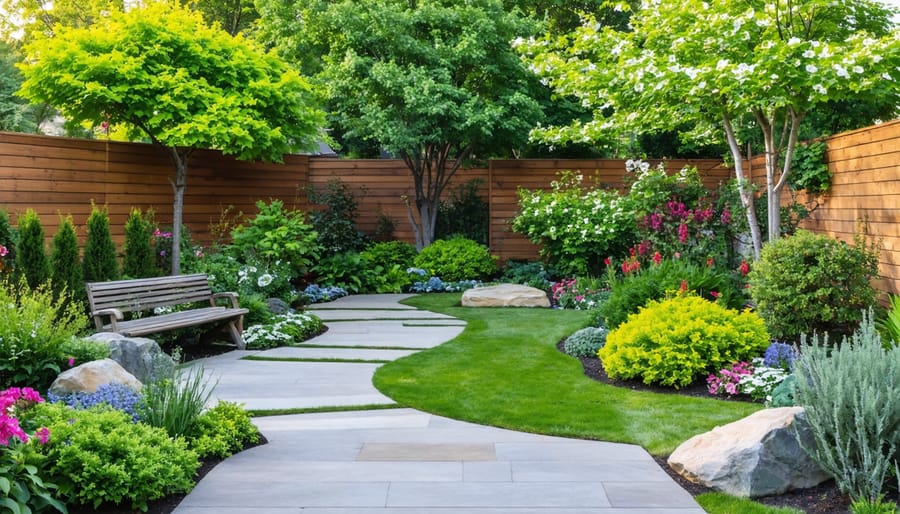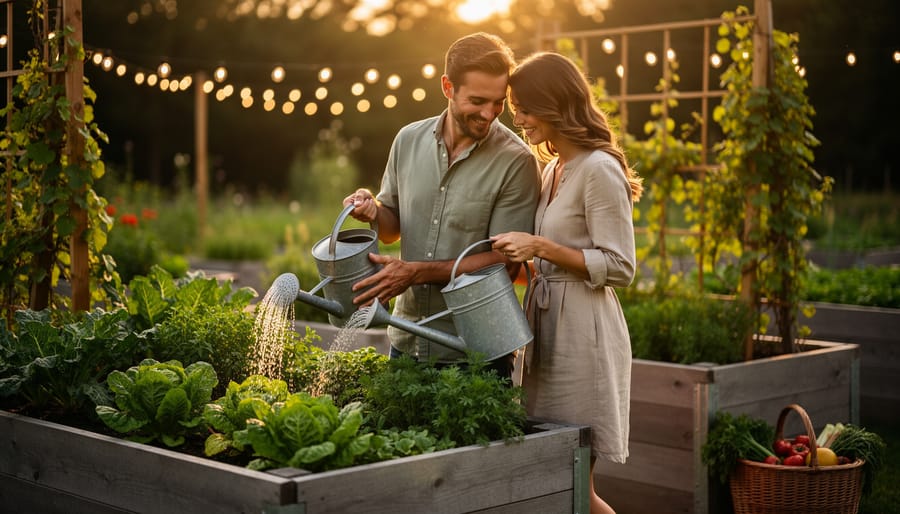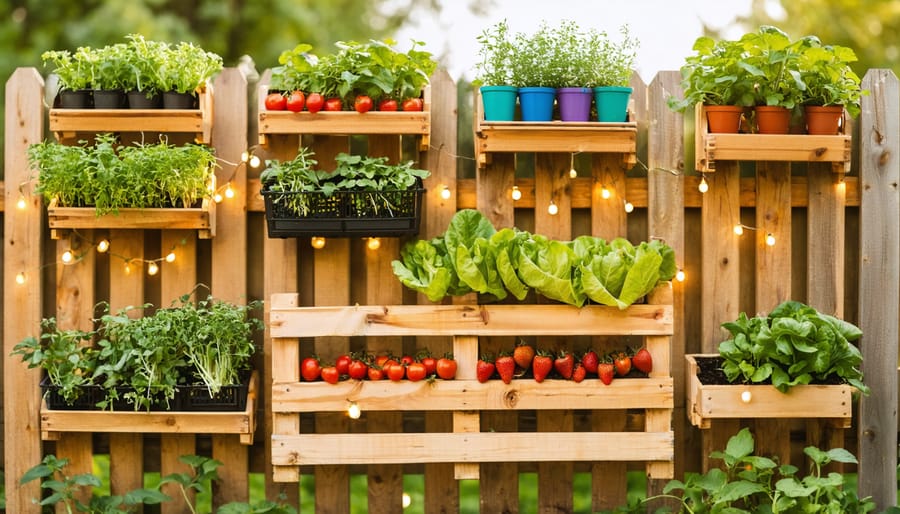Transform your outdoor space into a living masterpiece by combining strategic design with thoughtful plant selection. Start by mapping your yard’s unique conditions – sunlight patterns, soil types, and drainage areas – to transform your yard into a sustainable ecosystem. Layer your plantings vertically, positioning tall structural elements like trees and architectural shrubs first, then filling middle zones with flowering perennials and ground covers for continuous visual interest. Create focal points using specimen plants or hardscape features that draw the eye through the landscape while establishing clear sight lines and movement patterns. Incorporate native species strategically throughout your design to support local wildlife and reduce maintenance needs, while ensuring year-round beauty through careful consideration of bloom times, foliage colors, and seasonal interest. Whether you’re working with a compact urban garden or sprawling suburban lot, successful landscape design bridges artistic vision with practical functionality, creating outdoor spaces that flourish in harmony with nature.
Creating Your Landscape Vision
Analyzing Your Space
Before diving into plant selection and design, it’s crucial to understand your yard’s unique characteristics. Start by observing how sunlight moves across your space throughout the day. Make notes of which areas receive full sun (6+ hours), partial sun (4-6 hours), or shade. This information will be invaluable when choosing plants that will thrive in your landscape.
Next, examine your soil quality. Grab a handful and feel its texture – is it sandy, clay-like, or somewhere in between? Consider conducting a simple soil test to determine its pH and nutrient levels. This small investment can save you from countless plant problems down the road.
Water patterns in your yard are equally important. After a good rain, walk around and notice where water pools or flows. Look for signs of erosion or consistently wet areas. These observations will help you plan proper drainage solutions and choose plants that match your yard’s natural moisture levels.
Don’t forget to consider existing features like trees, structures, and utility lines. Map out these elements and note how they affect your space. Are there deep-rooted trees competing for water? Does your house cast long shadows? Understanding these factors will help you create a landscape that works in harmony with your property’s natural conditions.
Remember, successful gardening starts with working with nature, not against it. Take your time with this analysis – it’s the foundation of your landscape’s success.

Design Principles That Create Harmony
Creating harmony in your landscape begins with understanding and applying key design principles that professional gardeners have relied on for generations. Balance is the foundation of pleasing garden design, achieved through either symmetrical arrangements (mirror images on both sides) or asymmetrical designs that create visual equilibrium using different elements.
Rhythm guides the eye through your garden space, created by repeating plants, colors, or hardscape elements at regular intervals. Think of it as creating a visual melody that leads visitors through your outdoor sanctuary. This might mean planting clusters of ornamental grasses at key points or using the same type of flowering shrub to create continuity.
Focal points serve as anchor elements that draw attention and create interest. This could be a striking specimen tree, an artistic water feature, or a beautifully crafted garden bench. The key is to limit focal points to avoid visual competition – too many statement pieces can create chaos rather than harmony.
Unity ties everything together through consistent use of materials and a cohesive color palette. Consider using similar materials for pathways and borders, or choosing a color theme that flows throughout the space. Scale and proportion ensure elements relate well to each other and your home’s architecture. A tiny garden bed against a large house wall might feel underwhelming, while oversized features can overwhelm a small space.
Remember, these principles are guidelines rather than strict rules. The most harmonious gardens often come from understanding these concepts and then adapting them to your unique style and space.
Strategic Plant Selection
Layer Your Plants Like a Pro
Just as nature creates beautiful layers in forests, learning to layer your garden plants can transform your landscape into a rich, dynamic space. Think of your garden as a living painting, with each layer contributing to the overall composition.
Start with the tallest elements as your backdrop – trees and large shrubs create the foundation and provide vertical interest. These anchor plants establish structure and year-round presence in your garden. In front of these, position medium-height shrubs and larger perennials, which act as the middle ground of your composition.
The next layer should feature shorter perennials and ornamental grasses, creating a transition zone that draws the eye through the garden. Finally, edge your beds with ground covers and low-growing plants that spill onto pathways and fill in gaps between larger specimens.
Remember to consider bloom times and seasonal interest when selecting plants for each layer. Aim for a mix of textures and forms – pair feathery ferns with broad-leaved hostas, or combine spiky ornamental grasses with rounded flowering shrubs.
For the most natural look, plant in groups rather than single specimens, and allow plants to weave together as they would in nature. This approach not only creates visual harmony but also supports beneficial insects and wildlife, making your garden a thriving ecosystem.

Color Through the Seasons
Creating a landscape that captivates throughout the year requires thoughtful planning and strategic plant selection. Think of your garden as a living canvas that transforms with each season, offering continuous visual interest even as temperatures change.
Start with spring-flowering bulbs like tulips and daffodils, complemented by early-blooming shrubs such as forsythia and flowering quince. Layer these with perennials that will emerge as the bulbs fade, creating a seamless transition into summer.
Summer brings endless possibilities, from vibrant flowering perennials to ornamental grasses that catch the light. Include long-blooming varieties like black-eyed susans and salvias, which provide reliable color from June through September.
As autumn approaches, incorporate plants known for their fall foliage. Japanese maples, burning bush, and oakleaf hydrangeas offer spectacular seasonal displays. Don’t forget late-blooming perennials like asters and chrysanthemums to maintain color as other plants begin to fade.
Winter needn’t be colorless. Evergreens provide year-round structure, while plants with colorful bark like red-twig dogwood add striking visual interest against snow. Berry-producing shrubs such as winterberry holly not only provide food for birds but also create stunning winter scenes.
Remember to consider plant placement carefully, ensuring each season’s stars are visible from key viewing areas. Group plants with similar blooming periods to create impact zones that draw the eye as the seasons change.

Native Plants for Sustainable Beauty
Embracing native plant landscaping is one of the most rewarding choices you can make for your outdoor space. Native plants have evolved alongside local wildlife, creating perfect harmony in your garden while requiring minimal maintenance and resources.
These resilient plants are naturally adapted to your region’s climate, soil conditions, and rainfall patterns. This means they typically need less watering, fertilizing, and pest control than non-native species. I’ve found that once established, native plants practically take care of themselves!
When selecting native plants, consider your specific growing conditions. Look for species that match your yard’s sunlight exposure, soil type, and moisture levels. Some excellent choices might include flowering perennials like coneflowers and black-eyed susans, which attract pollinators, or native grasses that provide year-round visual interest.
The benefits extend beyond easy maintenance. Native plants support local wildlife, including birds, butterflies, and beneficial insects. They help prevent soil erosion, improve water quality, and reduce the need for chemical treatments. Plus, they create a unique sense of place, connecting your landscape to the natural heritage of your region.
Remember to group plants with similar water needs together and consider their mature sizes when planning. Your local extension office or native plant society can recommend specific varieties that will thrive in your area.
Hardscape Elements That Enhance
Pathways and Borders
Pathways and borders are the arteries of your garden, guiding movement and creating visual flow throughout your outdoor space. Well-designed paths not only provide practical access but also invite exploration and create a sense of journey through your landscape. Consider using materials that complement your home’s architecture – natural stone for traditional settings, or sleek concrete pavers for modern designs.
When planning pathways, think about traffic patterns and daily use. Main walkways should be at least 4 feet wide to allow comfortable side-by-side walking, while secondary garden paths can be narrower at 2-3 feet. Gentle curves are more inviting than straight lines and create intrigue by partially concealing what lies ahead.
Borders play a crucial role in defining spaces and creating structure. Use a mix of plants with varying heights, textures, and blooming seasons to maintain year-round interest. Plant taller specimens at the back, medium-height plants in the middle, and low-growing varieties in front. This layered approach creates depth and visual harmony while complementing your landscape lighting design after dark.
Edge your paths and borders with hardy plants or permanent materials like steel edging or stone to maintain clean lines and prevent grass invasion. Consider incorporating small sitting areas where paths intersect, creating natural pause points to enjoy your garden. Remember to leave enough space between plants for mature growth, and use repetition of key plants or materials to create a cohesive look throughout your landscape.

Features That Draw the Eye
Every memorable landscape needs features that capture attention and create visual interest throughout the seasons. A well-placed focal point can transform an ordinary garden into an extraordinary outdoor sanctuary. Water features, like a bubbling fountain or a small pond, not only draw the eye but also provide soothing sounds and attract wildlife, creating a multi-sensory experience.
Natural stone elements serve as excellent anchors in the landscape. Consider incorporating a boulder grouping, a dry creek bed, or a decorative gravel path. These elements add texture and permanence while requiring minimal maintenance. For vertical interest, arbors and pergolas create architectural drama while supporting climbing plants like wisteria or clematis.
Garden art can inject personality into your landscape. Weather-resistant sculptures, decorative stakes, or even repurposed vintage items can become conversation pieces. Position these elements where they’ll be visible from key viewing points, such as windows or seating areas. Remember that less is often more – too many focal points can create visual chaos.
Lighting plays a crucial role in extending your garden’s appeal into the evening hours. Strategic placement of solar or low-voltage lights can highlight special features and create magical nighttime scenes. Consider uplighting specimen trees, illuminating pathways, or adding subtle spotlights to architectural elements.
For year-round interest, incorporate plants with striking characteristics. Ornamental grasses provide movement and sound, while plants with interesting bark or winter berries maintain visual appeal during dormant seasons. A thoughtfully placed specimen tree or an unusual shrub can become a natural focal point that grows more impressive with time.
Making It All Work Together
Installation Timeline
Creating a beautiful landscape takes careful planning and proper timing. The most successful landscape installations follow a well-thought-out timeline that considers both seasonal factors and plant establishment needs. Here’s how to phase your landscape project for the best results:
Start with hardscaping elements in early spring or fall when the weather is mild. This includes installing pathways, retaining walls, and other structural features. These elements form the backbone of your landscape and should be completed before any major planting begins.
Next, focus on larger plants and trees during the dormant season – typically late fall through early spring. This timing gives woody plants the best chance to establish strong root systems before the stress of summer heat. When planting trees, allow adequate spacing for mature growth to prevent overcrowding years down the line.
Mid-spring is ideal for installing your irrigation system and preparing planting beds. Take time to amend soil properly and establish efficient watering zones. This groundwork is crucial for long-term plant health and water conservation.
Late spring through early summer is perfect for adding shrubs and perennials. These plants benefit from warm soil temperatures and typically have time to establish before winter. Space your planting over several weekends to avoid overwhelming yourself and to ensure each plant receives proper attention during installation.
Save annual flowers and decorative elements for the final phase. These finishing touches can be added once the main structural elements and permanent plantings are established. This approach allows you to adjust your color scheme and fill any gaps that become apparent as your landscape matures.
Remember to allow time between phases for plants to settle and for you to evaluate the design’s flow. This measured approach might take longer initially, but it leads to a more successful and sustainable landscape that you’ll enjoy for years to come.
Smart Maintenance Strategies
A well-planned maintenance strategy is essential for keeping your landscape beautiful and thriving throughout the years. The key to successful low-maintenance garden design lies in making smart choices from the beginning and establishing efficient care routines.
Start by creating a seasonal maintenance calendar that outlines regular tasks like pruning, fertilizing, and mulching. Spring calls for cleaning up winter debris, while summer focuses on watering and deadheading. Fall is perfect for planting bulbs and preparing for winter, which mainly involves protecting sensitive plants and maintaining hardscape elements.
Group plants with similar water and care requirements together to streamline maintenance efforts. This approach, known as hydrozoning, not only saves time but also ensures more efficient resource use. Install an automated irrigation system with smart controls to deliver the right amount of water exactly where and when it’s needed.
Invest in quality mulch to suppress weeds and retain soil moisture. Apply a 2-3 inch layer around plants, refreshing it annually. Consider using landscape fabric in areas prone to aggressive weed growth, but remember to leave room for desired plants to spread naturally.
Implement integrated pest management (IPM) strategies by encouraging beneficial insects and birds. Plant native species that naturally resist local pests and diseases, and regularly monitor your garden for early signs of problems. When issues arise, start with the least toxic solution first.
Make maintenance easier by choosing appropriate tools and keeping them well-organized and properly maintained. A tool shed or storage system near your garden saves time and energy. Consider investing in quality, ergonomic tools that will last for years and make garden work more enjoyable.
Remember that a truly sustainable landscape evolves over time. Regular observation and minor adjustments will help your garden mature beautifully while keeping maintenance requirements manageable and enjoyable.
As we’ve explored throughout this guide, transforming your outdoor space through thoughtful landscape design and strategic planting is both an art and a science. By following the principles we’ve discussed – from careful planning and site analysis to selecting the right plants and implementing sustainable practices – you can create a beautiful, functional landscape that brings joy for years to come.
Remember that successful landscape design isn’t about getting everything perfect immediately. It’s an evolving process that grows and develops alongside your garden. Start with a solid plan, but don’t be afraid to adjust and experiment as you learn what works best in your unique space. Whether you’re working with a small urban garden or a sprawling suburban yard, the key is to remain patient and consistent with your vision.
Take inspiration from the design concepts we’ve shared, but make them your own. Your landscape should reflect your personality and lifestyle while serving the practical needs of your household. Consider starting with a small area first, perhaps a welcoming entryway garden or a cozy patio space, and gradually expand your design as your confidence grows.
The rewards of thoughtful landscape design extend far beyond aesthetic appeal. You’re creating an outdoor sanctuary that supports local wildlife, contributes to environmental sustainability, and provides a peaceful retreat for yourself and your loved ones. So grab your planning tools, put on your gardening gloves, and take that first step toward creating your dream landscape. Your outdoor transformation journey begins now!




